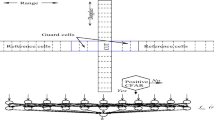Summary
Over the last few years, the potential for the application of pattern recognition techniques (including neural networks), has been investigated at The Met Office, with the aim of improving the use of satellite imagery in numerical weather prediction and in other quantitative forecasting systems. Neural networks, for example, enable the use of diverse inputs, are capable of learning highly nonlinear discriminant functions, and can be very fast when used operationally.
For the British Isles, the best nowcasting precipitation information comes from a network of 15 radars, which is used to forecast cloud and precipitation within the Met Office’s automatic nowcasting system, Nimrod (Golding, 1998). Visible and infrared satellite images are used optimally by combining them with radar and other data, to remove spurious radar signals, or as independent information outside the radar network. The requirement for satellite precipitation estimates in Nimrod can be summarized as discriminating no rain from light rain, at a threshold of , in 15 minute intervals, at a spatial resolution of 5 km. This paper describes the development of a new neural network scheme based on the use of Meteosat infrared, or visible and infrared imagery, to determine a probability of precipitation within the Nimrod domain, for use in removing spurious echoes from Nimrod radar composite images.
The neural networks were trained on samples taken from 3200 boxes of 17 × 17 pixels, selected from 48 sets of Meteosat and radar images, taken throughout the period July 1995 to June 1997 during day or night. Feature selection was performed on the images to look at the ability of various visible and infrared features calculated over different sized regions to discriminate light rain from no rain. Two multilayer perceptron neural network classifiers were trained using the features obtained, and were found to provide overall probabilities of detection of 66% for infrared and 69% for visible and infrared features, for a 1:2.8 wet to dry ratio of pixels used for testing. These can be compared with estimates for the Meteosat step of the current Nimrod scheme which removes spurious radar echoes, of 61% and 47% for cold frontal cases, but of 28% and 74% respectively for cold-air convection.
The new neural network scheme was trialled during summer and winter 1998, and although it was found to provide better diagnosis of spurious echoes during summer, and better diagnosis of rain during winter, it provided a slightly worse diagnosis of rain during summer and a worse diagnosis of spurious echoes during winter. Part of these problems are thought to be associated with the lack of surface temperature data used in the new scheme, and the way in which the rain is deleted near strong cloud edges.
The major contender for improving the removal of spurious radar echoes is to convert the network to Doppler radars. However, this is unlikely to happen in the next 5 to 10 years. As it is thought that nearly all of the problems with the neural network scheme can be remedied, it is planned to continue with its development, by including surface temperature, snow cover and surface climatological albedo fields.
Similar content being viewed by others
Author information
Authors and Affiliations
Additional information
Received October 15, 1999 Revised April 15, 2000
Rights and permissions
About this article
Cite this article
Pankiewicz, G., Johnson, C. & Harrison, D. Improving radar observations of precipitation with a Meteosat neural network classifier. Meteorol Atmos Phys 76, 9–22 (2001). https://doi.org/10.1007/s007030170036
Issue Date:
DOI: https://doi.org/10.1007/s007030170036




